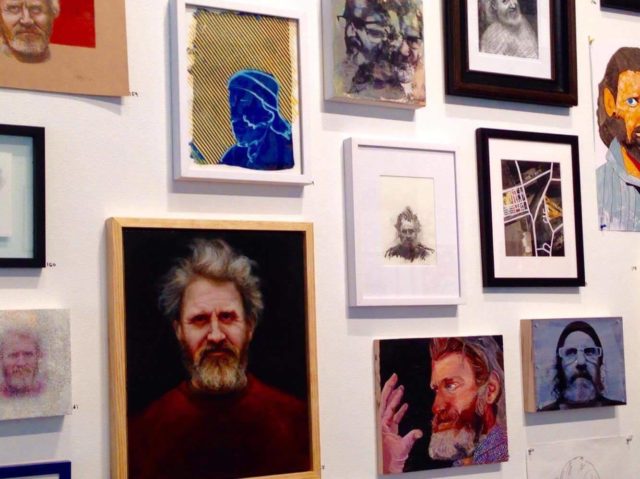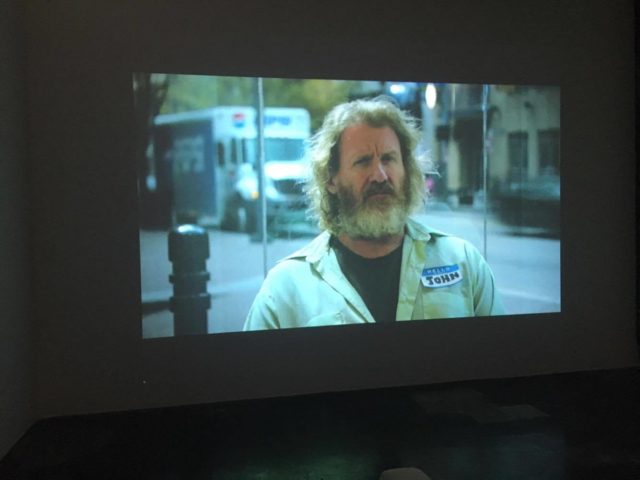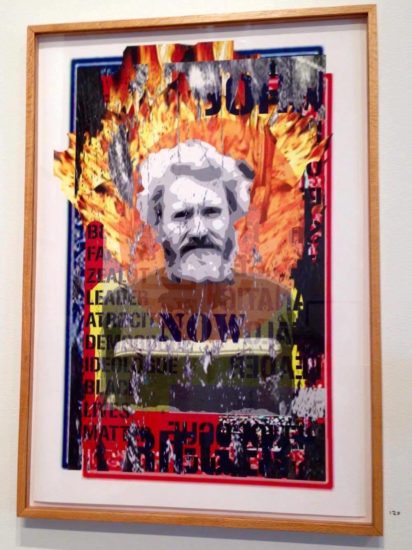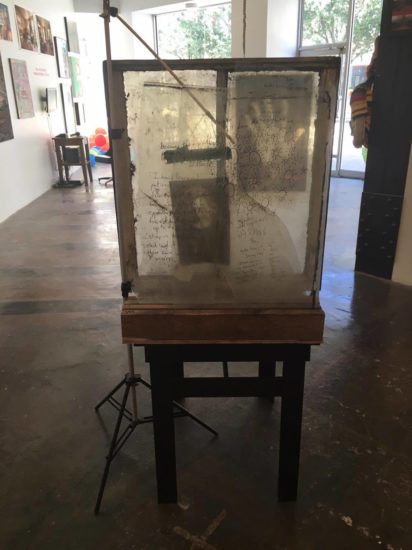
Installation view of ‘John Riegert’ at SPACE (all images by author for Art F City)
John Riegert
SPACE
812 Liberty Avenue, Pittsburgh, PA
On view until September 4, 2016
PITTSBURGH–Who is John Riegert? And why are there 243 portraits of him in a current exhibition at SPACE, one of Pittsburgh’s main downtown galleries?
Organized by Brett Yasko, the exhibition, John Riegert, centers around 252 Pittsburgh artists’ interpretations of Riegert, a local artist and writer who acts as a singular subject to showcase the range of Pittsburgh’s creative community. Even with a staggering amount portraits scattered around SPACE, the exhibition somehow becomes less about Riegert as an individual. Instead, the show is more about presenting a democratic snapshot of Pittsburgh’s vibrant arts scene–one that exists outside the main American art world poles of New York and Los Angeles.
Much of this has to do with Yasko’s initial curatorial impulse. According to Yasko, the impetus for the project came after he noticed the similarities between Joseph Yoakum’s landscape paintings in the 2013 Carnegie International and local artist Judy Tulley (also included in John Riegert) who shares her art with relatives. He wondered about the nature of being an artist and why one artist becomes institutionally recognized while another remains in obscurity.
Mining these divisions between professional and amateur artists, Yasko decided to show off the diversity of art making within Pittsburgh by organizing a show focusing on one subject. Enter John Riegert. Struggling with mental illness, Riegert had stopped making art and disappeared from the arts community where he was once well-known. He recently began recovering and became the ideal subject for Yasko in part because he had enormous amounts of free time (he is on disability). He also showed a willingness to devote his energy to the needs of other artists.

Installation view of the video gallery in SPACE’s John Riegert
Starting in February 2015, numerous artists met with Riegert either individually or in group sittings to record his likeness. Others who were not able to meet him in person worked from a photograph provided by Yasko. The expansive and ambitious cumulative effort fills SPACE to absolute capacity and becomes a bizarrely heart-warming type of “welcome back” party for an artist by a small arts community.
Further adding to his participation, Riegert himself also acts as the exhibition’s docent. For the entire run of the exhibition, Riegert is present, telling stories of the artists and their collaborations. Yasko encourages these conversations by forgoing labels on the works to allow people to interact with Riegert. And yet, as most docents have experienced, sometimes you get monopolized by one time-sucking attendee and for Riegert, it was no different. When I saw the show, Riegert was in a deep and clearly long-winded philosophical conversation with another viewer. However, his simple physical presence in the gallery added an uncanny confusion between the original Riegert and the over 200 reproductions.
Admittedly, the exhibition is terrifying. With walls hung floor to ceiling with images of Riegert, you feel like you’ve entered a Twilight Zone for the art world. With his long greying hair, beard, blue eyes and elusive gaze, bearing more than a passing resemblance to Jeff Bridges’ beloved character “The Dude” from The Big Lebowski, Riegert is everywhere you look–in paintings, sculptures, photographs, videos and installations. The sheer volume of Riegerts in the gallery inspires the impulse to flee. It’s like being surrounded by a clone experiment gone wrong.

Robert Beckman’s portrait of John Riegert
With 252 artists, the show includes a large swath of the Pittsburgh arts scene, which frankly isn’t that big to begin with. What can we learn about Pittsburgh art through the exhibition? First and most noticeably, the community’s sheer diversity of expression. The portraits range from traditional paintings by Christopher McGinnis to an interactive 3-D digital model of Riegert, presented on a computer, by Caroline Record and Ricardo Iamuuri Robinson.
This multiplicity of artistic strategies also extends to the content of the work despite the seemingly monomaniacal focus on Riegert. Some portraits take on a political resonance such as Robert Beckman’s collage, which features a black-and-white image of Riegert on top of a background of flames. Words such as “zealot,” “leader,” and “Black Lives Matter” are emblazoned on the side of the work. Conversely, other works deal more with Riegert’s daily emotional wellbeing as seen in Elana Schlenker’s colorful, balloon-filled window installation. Riegert inflates a balloon daily that is color-coded to correspond to his mood.
As can be expected with a show of its size and inclusive vision, some works are good, some are bad and many fall somewhere in between. The most successful works in the show seem to be the ones that experiment with the boundaries and strictures of portraiture rather than rely on more traditional representational mediums.

The table in Lenka Clayton’s portrait of John Riegert
Take, for example, Lenka Clayton’s installation that pairs a list by Riegert titled “List #1: Dining Room Table” and a table set with the exact items mentioned on the scrap of notebook paper. Clayton found the list in Riegert’s attic, which doubles as his art storage room. Transforming this list into reality, the table is not set with dishware but with the remnants of a bohemian lifestyle–cigarette filters, tumblers covered in leftover bourbon residue and a giant jug of Elmer’s glue.
Somehow these seemingly random items on a table, including a blond wig that resembles Riegert’s actual hair, become a testament to a certain romanticized, substance-based creative process of an artist or a writer. With the combination of the object-laden table and the touch of his written hand on the forgotten list, Clayton’s inclusion in the exhibition becomes a portrait of Riegert even without his physical body.

Renee Rosensteel’s portrait of John Riegert
Despite the glut of portraits of Riegert, as well as his presence in the gallery, there still remains something mysterious about the artist. Renee Rosensteel’s standing sculpture perhaps best exemplifies how the exhibition, in some ways, reminds us that it’s impossible to know everything about a person. Her work resembles Duchamp’s The Bride Stripped Bare by Her Bachelors, Even with its layers of glass, paper, writing and black-and-white photographs. In addition to the visible text, Rosensteel also placed a piece of writing by Riegert into a locked box that acts as the base of the sculpture. No one but Riegert will ever be able to know what his secretive piece of writing says. This box becomes a clever reference to the frustrating impossibility of fully documenting a subject through portraiture. A clue to a subject’s personae, the artist’s intent or even, the art scene they inhabit will always remain locked. The piece, like the exhibition as a whole, leaves viewers wanting more.


Comments on this entry are closed.